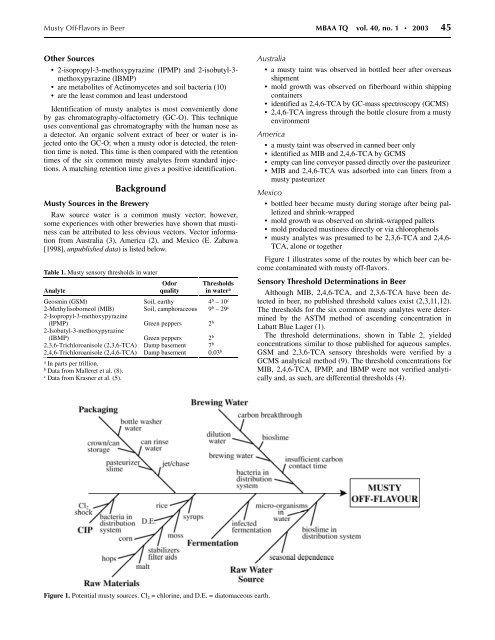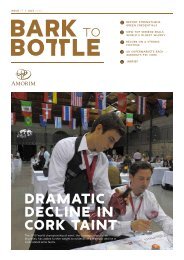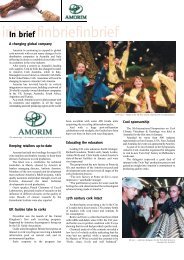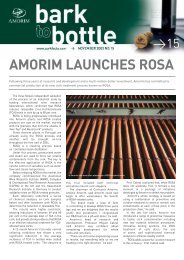Identification, Cause, and Prevention of Musty Off-Flavors in Beer
Identification, Cause, and Prevention of Musty Off-Flavors in Beer
Identification, Cause, and Prevention of Musty Off-Flavors in Beer
Create successful ePaper yourself
Turn your PDF publications into a flip-book with our unique Google optimized e-Paper software.
<strong>Musty</strong> <strong>Off</strong>-<strong>Flavors</strong> <strong>in</strong> <strong>Beer</strong> MBAA TQ vol. 40, no. 1 2003 45<br />
Other Sources<br />
2-isopropyl-3-methoxypyraz<strong>in</strong>e (IPMP) <strong>and</strong> 2-isobutyl-3methoxypyraz<strong>in</strong>e<br />
(IBMP)<br />
are metabolites <strong>of</strong> Act<strong>in</strong>omycetes <strong>and</strong> soil bacteria (10)<br />
are the least common <strong>and</strong> least understood<br />
<strong>Identification</strong> <strong>of</strong> musty analytes is most conveniently done<br />
by gas chromatography-olfactometry (GC-O). This technique<br />
uses conventional gas chromatography with the human nose as<br />
a detector. An organic solvent extract <strong>of</strong> beer or water is <strong>in</strong>jected<br />
onto the GC-O; when a musty odor is detected, the retention<br />
time is noted. This time is then compared with the retention<br />
times <strong>of</strong> the six common musty analytes from st<strong>and</strong>ard <strong>in</strong>jections.<br />
A match<strong>in</strong>g retention time gives a positive identification.<br />
Background<br />
<strong>Musty</strong> Sources <strong>in</strong> the Brewery<br />
Raw source water is a common musty vector; however,<br />
some experiences with other breweries have shown that must<strong>in</strong>ess<br />
can be attributed to less obvious vectors. Vector <strong>in</strong>formation<br />
from Australia (3), America (2), <strong>and</strong> Mexico (E. Zabawa<br />
[1998], unpublished data) is listed below.<br />
Table 1. <strong>Musty</strong> sensory thresholds <strong>in</strong> water<br />
Analyte<br />
Odor<br />
quality<br />
Thresholds<br />
<strong>in</strong> watera Geosm<strong>in</strong> (GSM) Soil, earthy 4b – 10c 2-Methylisoborneol (MIB) Soil, camphoraceous 9b – 29c 2-Isopropyl-3-methoxypyraz<strong>in</strong>e<br />
(IPMP)<br />
Green peppers 2b 2-Isobutyl-3-methoxypyraz<strong>in</strong>e<br />
(IBMP)<br />
Green peppers<br />
2,3,6-Trichloroanisole (2,3,6-TCA) Damp basement 7 b<br />
2,4,6-Trichloroanisole (2,4,6-TCA) Damp basement 0.03 b<br />
a In parts per trillion.<br />
b Data from Malleret et al. (8).<br />
c Data from Krasner et al. (5).<br />
Figure 1. Potential musty sources. Cl 2 = chlor<strong>in</strong>e, <strong>and</strong> D.E. = diatomaceous earth.<br />
2 b<br />
Australia<br />
a musty ta<strong>in</strong>t was observed <strong>in</strong> bottled beer after overseas<br />
shipment<br />
mold growth was observed on fiberboard with<strong>in</strong> shipp<strong>in</strong>g<br />
conta<strong>in</strong>ers<br />
identified as 2,4,6-TCA by GC-mass spectroscopy (GCMS)<br />
2,4,6-TCA <strong>in</strong>gress through the bottle closure from a musty<br />
environment<br />
America<br />
a musty ta<strong>in</strong>t was observed <strong>in</strong> canned beer only<br />
identified as MIB <strong>and</strong> 2,4,6-TCA by GCMS<br />
empty can l<strong>in</strong>e conveyor passed directly over the pasteurizer<br />
MIB <strong>and</strong> 2,4,6-TCA was adsorbed <strong>in</strong>to can l<strong>in</strong>ers from a<br />
musty pasteurizer<br />
Mexico<br />
bottled beer became musty dur<strong>in</strong>g storage after be<strong>in</strong>g palletized<br />
<strong>and</strong> shr<strong>in</strong>k-wrapped<br />
mold growth was observed on shr<strong>in</strong>k-wrapped pallets<br />
mold produced must<strong>in</strong>ess directly or via chlorophenols<br />
musty analytes was presumed to be 2,3,6-TCA <strong>and</strong> 2,4,6-<br />
TCA, alone or together<br />
Figure 1 illustrates some <strong>of</strong> the routes by which beer can become<br />
contam<strong>in</strong>ated with musty <strong>of</strong>f-flavors.<br />
Sensory Threshold Determ<strong>in</strong>ations <strong>in</strong> <strong>Beer</strong><br />
Although MIB, 2,4,6-TCA, <strong>and</strong> 2,3,6-TCA have been detected<br />
<strong>in</strong> beer, no published threshold values exist (2,3,11,12).<br />
The thresholds for the six common musty analytes were determ<strong>in</strong>ed<br />
by the ASTM method <strong>of</strong> ascend<strong>in</strong>g concentration <strong>in</strong><br />
Labatt Blue Lager (1).<br />
The threshold determ<strong>in</strong>ations, shown <strong>in</strong> Table 2, yielded<br />
concentrations similar to those published for aqueous samples.<br />
GSM <strong>and</strong> 2,3,6-TCA sensory thresholds were verified by a<br />
GCMS analytical method (9). The threshold concentrations for<br />
MIB, 2,4,6-TCA, IPMP, <strong>and</strong> IBMP were not verified analytically<br />
<strong>and</strong>, as such, are differential thresholds (4).






